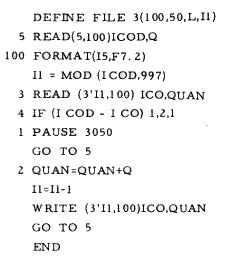|
Machine languages
Like all the machines, the calculation machine is able to execute only what was said to do and in the way it was indicated.
The "Code Program" is a series of instructions that the machine must execute step by step to develop automatically its work and they are set in its memory before the beginning of the work itself.
To instruct a calculation machine or to program it, it means to identify through an extremely, elementary and particular scheme.
The block diagram, all the mathematics and logic operations that the machine must execute according to an order foreseeing also the eventual alternative that are found to solve the problem.
This scheme is then converted into the real elementary directions that must be executed by the machine.
To do a program is so a long and hard work, but then the calculation machine doesn't need anymore the human investigation and it can work automatically at the speed its electric circuits all, executing the same program thousand times on a day and always accurately.
The only language the calculation machine understands directly is made by numbers.
Every program is so made by a very long series of binary digits, that the machine understands, because it knows for example that 0110 means "execute the multiplication" or 1011 means "put the number into the memory".
This "machine language" hasn't for a man any immediately meaning and it's very difficult to remember and to apply without making mistakes.
In 1957, after years of studies, a group of IBM experts sets a symbolic language known as FORTRAN.
It arises so the "symbolic languages"; they replace the numbers with the letters that show the meaning of them.
Naturally it is necessary to introduce at the beginning in the machine some particular directions, that allow the calculation machine to translate automatically the various initials met in the known language made by 1 and 0.
This language much nearer to the normal one spoken by man, is particularly suitable to express directions that resolve mathematics, technical and scientific problems.
Using FORTRAN man expresses himself through known words as "let's multiply", "let's calculate" etc. then the calculation machine transforms them automatically in machine language.
At the beginning of sixtieth it were developed some programming symbolic languages that made easy the use of the machine also to the unskilled persons, the possibilities of mistakes and the necessary time to plan the calculation machine for work reduced.
In addiction to the FORTRAN (Formula Translator), a calculation machine universal language, because of scientific and technical problems, it was defined as the first P.O. language (Problem Oriented), a big success has also the COBOL (Common Business Oriented Language) that utilises the words normally used by the business language and it is studied for the commercial and administrative applications.
The COBOL has reached a big success because of its adaptability to not complex operations on a large quantity of data.
Even if it hasn't the same diffusion, the ALGOL (ALGOrithmic Language), it has influenced the evolution of the FORTRAN and other languages as the Pascal, that was developed about in 1968 by Niklaus Wirth and Kathleen Jensen.
In parallel to the languages development, also the programming techniques has been developed in the same period, they allow to set programs that carry out repetitive tasks or assign to the machine itself the organisation of the time and of some works.
To make easy the programming work, some Computer Factories make and put into business programs ready to be used.
These are made to solve common problems, then the users must customize them with few data according to their specific needs.
|
















